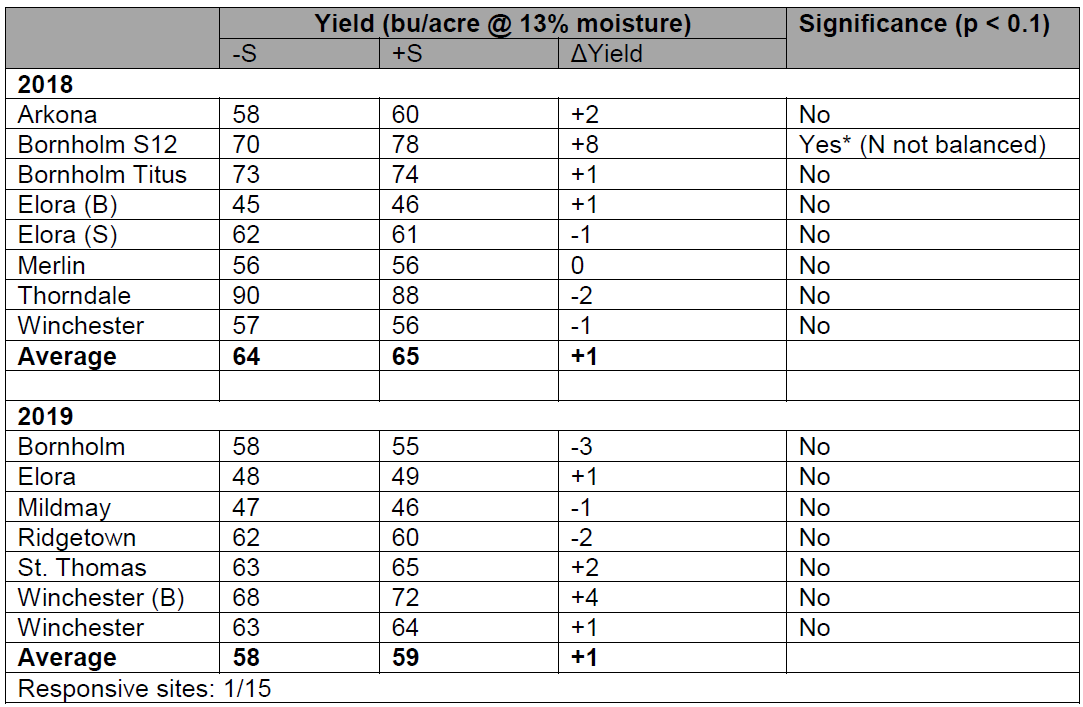Purpose
To determine the frequency and extent of sulphur deficiency and yield response to sulphur fertilization across a wide variety of soil and climatic conditions in Ontario for corn, winter wheat, and soybean following their typical rotation over three years. The project also aims to develop a sulphur soil test for the province.
Methods
Sulphur fertility yield response trials were conducted at various locations in 2018 and 2019 (Table 1) by a team of university researchers, OMAFRA staff, and grower cooperators. Field-length strip trials were performed on-farm and many small plot research sites were used as well.
Sulphur was spring-applied as an available sulphate or thiosulphate fertilizer source. The only exception to this was the 2019 Mildmay corn trial where MESZ was utilized, meaning that half the sulphur applied was in an elemental form. For simplicity, results presented here only compare the control yield to that for the sulphur rate closest to 20 lbs S/ac. Response results for this statistical analysis were identical to those from the full analysis of all sulphur rates.
Table 1: Summary of locations, experimental layouts, sulphur sources and rates for 2018 and 2019 sulphur fertility trials.

Results
Table 2: 2018 and 2019 winter wheat yield response to sulphur at various locations across Ontario.


Figure 1: Winter wheat yield response to sulphur application at the bottom vs top of the hill at the Mildmay 2019 on-farm location.
Table 3: Corn yield response to sulphur application at various locations across Ontario in 2018 and 2019.

Table 4: 2018 and 2019 soybean yield response to sulphur at various locations across Ontario


Figure 3: Sulphate of potash (SOP) applied PPI at 18 lbs S/ac vs no sulphur applied at the Elora (S) 2018 site.
Summary
Response to sulphur applications generally followed what we would expect in terms of crop species: more response in winter wheat than in corn and soybean. This study found a response in winter wheat for two out of eight locations while there was no significant response at any of the five corn locations. There was significant response at one in fifteen soybean trials, but the nitrogen supplied by the AMS in the responsive site was not balanced out in the control treatment. This leaves to question whether the yield increase was due to sulphur, nitrogen, or a combination of the two. Overall, the results match fairly well with previous work conducted in Ontario. However, this study is lacking sites with course-textured soils (which are expected to more frequently show response) and will be conducted over a third and final year in 2020 with the hope of addressing this gap. Work continues on a sulphur soil test. Greenhouse experiments are currently underway to compare a handful of potential extractants, with the optimum one to be tested and calibrated under field conditions.
Acknowledgements
This project was funded by the Grain Farmers of Ontario and the OMAFRA/UofG Partnership. This project was conducted by Dr. John Lauzon, Alex Sanders, Peter Zwart, Horst Bohner, Ben Rosser, Jake Munroe, Joanna Follings and a number of grower cooperators.
Project Contacts
For further information on this project please contact Joanna Follings, Cereals Specialist, OMAFRA, joanna.follings@ontario.ca.
